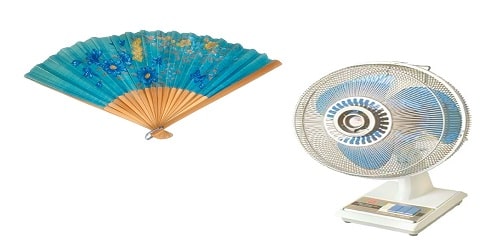Fan
The word fan came to Spanish through Portuguese, being a diminutive of “abano”, a word that designates a large instrument intended to produce wind to cool oneself, which, hung from the ceilings, managed to move with a pulley, which was maneuvered. It is considered the predecessor of modern ceiling fans.
The term abano was taken from the Latin “vannus” derived from “ventus” which translates as “wind”; Being then, a fan, a simple and light element, which produces, when moved, a little wind.
Most fans, instruments that emerged in the East and tinged with legends at their birth, are composed of rods, which form a skeleton called a deck, which are joined at the bottom in a radial shape. Under the union there is a handle that is used to take it, allowing a piece of fabric, cardboard or paper to be folded and unfolded, lace and feathers being common in the beginning (this part is known, whatever its material, as a country).
The fans can be semicircular or round, in the latter case, joined in the center, and are generally artistically decorated. When unfolded, when you move them with your hand from one side to the other, they generate a movement of refreshing air. Some fans are fixed.
The fan was an important fashion element, used in China during ceremonies (for example, in tea ceremonies) and in Japan in artistic fields, and it reached the European continent, brought by the Portuguese from the East in the 16th century. It was, until the 18th century, a symbol of the upper classes and royalty, being very expensive and sumptuous, used by both sexes, the men’s being characterized by being smaller in size, although it later evolved as an exclusive accessory for women, also considered, as a seductive element.
In the 18th century the use of the fan became popular, but today it has lost its validity, due to the existence of modern room cooling systems, although it can still be observed on hot days, the presence of ladies fanning themselves, in places where it is not counted. with ventilation devices.
In art
“The Lady with the Fan” is a painting from 1635, by the Spanish painter Diego Velázquez. The identity of the lady portrayed is controversial. Her hands are hidden in white gloves, holding the fan in her right and a rosary in her left.
Various dances, Chinese, Spanish, Arabic, Eastern European and Latin, are done with fans.
In nautical
Ship fans are made up of two poles, one vertical and the other inclined, attached to each other, used to suspend high weights, which resemble the format of a fan.
Fan Meaning in Hindi
पंखा(Fan) शब्द पुर्तगाली भाषा के माध्यम से स्पेनिश में आया, जो “अबानो” का एक छोटा रूप है, एक ऐसा शब्द जो खुद को ठंडा करने के लिए हवा पैदा करने के उद्देश्य से एक बड़े उपकरण को दर्शाता है, जिसे छत से लटकाया जाता था, जो एक चरखी के साथ हिलने में कामयाब होता था, जिसे घुमाया जाता था। इसे आधुनिक छत के पंखों का पूर्ववर्ती माना जाता है।
अबानो शब्द लैटिन “वैनस” से लिया गया था जो “वेंटस” से निकला है जिसका अनुवाद “हवा” होता है; तब, एक पंखा, एक सरल और हल्का तत्व, जो हिलाए जाने पर, थोड़ी हवा पैदा करता है।
अधिकांश पंखे, पूर्व में उभरे और अपने जन्म के समय किंवदंतियों से जुड़े हुए उपकरण, छड़ से बने होते हैं, जो एक कंकाल बनाते हैं जिसे डेक कहा जाता है, जो नीचे एक रेडियल आकार में जुड़े होते हैं। संघ के नीचे एक हैंडल होता है जिसका उपयोग इसे लेने के लिए किया जाता है, जिससे कपड़े, कार्डबोर्ड या कागज के टुकड़े को मोड़ा और खोला जा सकता है, शुरुआत में फीता और पंख आम होते हैं (इस हिस्से को, चाहे इसकी सामग्री कुछ भी हो, एक देश के रूप में जाना जाता है)।
पंखे अर्धवृत्ताकार या गोल हो सकते हैं, बाद के मामले में, केंद्र में जुड़े हुए हैं, और आम तौर पर कलात्मक रूप से सजाए गए हैं। जब आप उन्हें खोलते हैं, जब आप उन्हें अपने हाथ से एक तरफ से दूसरी तरफ ले जाते हैं, तो वे ताज़ा हवा की गति उत्पन्न करते हैं। कुछ पंखे स्थिर होते हैं।
पंखा एक महत्वपूर्ण फैशन तत्व था, जिसका उपयोग चीन में समारोहों (उदाहरण के लिए, चाय समारोहों में) और जापान में कलात्मक क्षेत्रों में किया जाता था, और यह 16वीं शताब्दी में पूर्व से पुर्तगालियों द्वारा लाए जाने पर यूरोपीय महाद्वीप तक पहुँच गया। 18वीं शताब्दी तक यह उच्च वर्ग और राजघरानों का प्रतीक था, बहुत महंगा और शानदार होने के कारण, दोनों लिंगों द्वारा इस्तेमाल किया जाता था, पुरुषों के पंखे का आकार छोटा होना इसकी विशेषता थी, हालांकि बाद में यह महिलाओं के लिए एक विशेष सहायक वस्तु के रूप में विकसित हुआ, जिसे एक आकर्षक तत्व भी माना जाता था।
18वीं शताब्दी में पंखे का उपयोग लोकप्रिय हो गया था, लेकिन आज आधुनिक कमरे के शीतलन प्रणालियों के अस्तित्व के कारण यह अपनी वैधता खो चुका है, हालांकि इसे अभी भी गर्म दिनों में देखा जा सकता है, महिलाओं को खुद को पंखा झलते हुए, उन जगहों पर देखा जा सकता है जहाँ इसे नहीं गिना जाता है। वेंटिलेशन उपकरणों के साथ।
कला में
“द लेडी विद द फैन” स्पेनिश चित्रकार डिएगो वेलाज़क्वेज़ द्वारा 1635 की एक पेंटिंग है। चित्रित महिला की पहचान विवादास्पद है। उसके हाथ सफेद दस्ताने में छिपे हुए हैं, उसके दाहिने हाथ में पंखा और बाएं हाथ में माला है।
चीनी, स्पेनिश, अरबी, पूर्वी यूरोपीय और लैटिन नृत्यों को पंखों के साथ किया जाता है।
समुद्री में
जहाज के पंखे दो खंभों से बने होते हैं, एक ऊर्ध्वाधर और दूसरा झुका हुआ, जो एक दूसरे से जुड़े होते हैं, जिनका उपयोग उच्च भार को लटकाने के लिए किया जाता है, जो पंखे के प्रारूप जैसा दिखता है।

